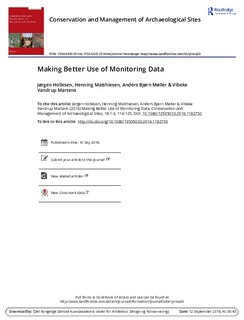| dc.contributor.author | Hollesen, Jørgen | |
| dc.contributor.author | Matthiesen, Henning | |
| dc.contributor.author | Møller, Anders Bjørn | |
| dc.contributor.author | Martens, Vibeke Vandrup | |
| dc.date.accessioned | 2017-10-24T09:22:05Z | |
| dc.date.available | 2017-10-24T09:22:05Z | |
| dc.date.created | 2015-09-07T09:42:47Z | |
| dc.date.issued | 2016 | |
| dc.identifier.citation | Conservation and Management of Archaeological Sites. 2016, 18 (1-3), 116-125. | |
| dc.identifier.issn | 1350-5033 | |
| dc.identifier.uri | http://hdl.handle.net/11250/2461685 | |
| dc.description | This is an Accepted Manuscript of an article published by Taylor & Francis in Conservation and Management of Archaeological Sites on 10 September 2016, available online: https://www.tandfonline.com/doi/full/10.1080/13505033.2016.1182750 | |
| dc.description.abstract | This paper addresses the knowledge gap that exists in relation to understanding and quantifying the sensitivity of organic-rich archaeological deposits with respect to changes in the soil environment. Based on two case studies we demonstrate that it is possible to quantify the current decay rate in unsaturated archaeological deposits by combining decay rates measured in the laboratory with on-site monitoring data in a simple decay model. The decay of organic archaeological deposits is highly sensitive to variations in soil temperatures and soil water content. Measurements of soil water content cannot always stand alone as a representative measurement of oxygen availability; which suggests that in situ measurements of oxygen content or redox potential are needed in order to understand the preservation conditions at a site. The results of this study emphasize the advantage of combining monitoring data with laboratory studies, in order to document in more detail where and when degradation takes place. | |
| dc.language.iso | eng | |
| dc.publisher | Routledge, Taylor & Francis Group | |
| dc.title | Making better use of monitoring data | |
| dc.type | Peer reviewed | |
| dc.type | Journal article | |
| dc.description.version | acceptedVersion | |
| dc.rights.holder | © Taylor & Francis Group 2016 | |
| dc.subject.nsi | VDP::Humaniora: 000 | |
| dc.subject.nsi | VDP::Humanities: 000 | |
| dc.source.pagenumber | 116-125 | |
| dc.source.volume | 18 | |
| dc.source.journal | Conservation and Management of Archaeological Sites | |
| dc.source.issue | 1-3 | |
| dc.identifier.doi | 10.1080/13505033.2016.1182750 | |
| dc.identifier.cristin | 1262269 | |
| dc.relation.project | Norges forskningsråd: 212900 | |
| cristin.unitcode | 7530,43,0,0 | |
| cristin.unitname | Arkeologiavdelingen | |
| cristin.ispublished | true | |
| cristin.fulltext | postprint | |
| cristin.qualitycode | 2 | |
